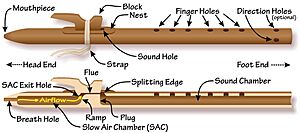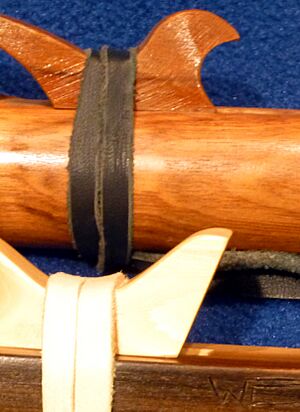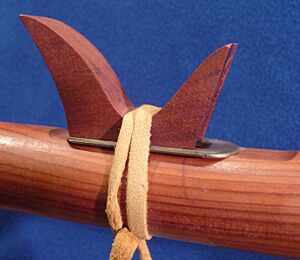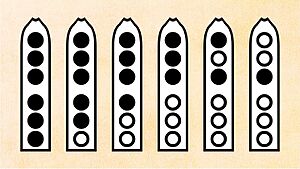Native American flute facts for kids
The Native American flute is a special musical instrument. It's a type of flute that you hold in front of you when you play. It has open holes for your fingers and is made of two main parts.
One part is where you blow air, and the other part is where the sound is made. A small piece on the outside, called a block, guides your breath from the first part to the second. This makes the air inside vibrate, which creates the beautiful sound of the flute.
Native American flutes come in many different shapes, sizes, and styles. There are far more kinds of Native American flutes than most other woodwind instruments!
Contents
What It's Called
The Native American flute has many other names. Some people call it the American Indian courting flute, love flute, or Grandfather's flute. You might also hear it called the Plains flute.
The correct way to write the name of this instrument is "Native American flute." The "N" in Native and the "A" in American are capital letters, but the "f" in flute is a small letter.
Someone who plays the Native American flute is usually called a "flutist."
A Look Back: History
There are many interesting stories about how different Native American peoples first created the Native American flute. One story tells of a woodpecker pecking holes in a tree branch while looking for termites. When the wind blew through these holes, people heard music!
We don't know much about how the flute's design changed before 1823. Some ideas for how it developed include:
- Tree branches or plant stalks with holes made by insects that made sounds in the wind.
- Musical instruments made of clay from Mesoamerica.
- The Anasazi flute, an old type of flute made by early Native American groups.
- Parts of the organ that make sound. Native Americans learned to make these parts as early as 1524.
- The recorder, a musical instrument that came from Europe.
It's also possible that instruments were brought from other places during migrations. The oldest Native American flute made of wood that we know of is from 1823. It is now in a museum in Italy.
How It's Built: Parts of the Flute
The Native American flute has two main sections inside: the slow air chamber and the sound chamber. A plug or internal wall separates these two chambers.
The slow air chamber is where you blow air. It's also called the "SAC" or mouth chamber. The sound chamber is where the music comes from. It can also be called the pipe body or tone chamber.
The block is a separate piece on the outside of the flute. It's often shaped like a bird. The block is tied onto the nest area of the flute with a strap. The block helps guide the air through a small channel called a flue from the slow air chamber to the sound chamber.
You blow into the mouthpiece of the slow air chamber through the breath hole. The air then flows through the slow air chamber and out an exit hole into the flue.
In the sound chamber, the air hits a sharp edge called the splitting edge. This creates a vibration that makes the sound. The opening where this happens is called the sound hole. It's also known as the whistle hole or window.
The sound chamber also has finger holes. When you cover or uncover these holes with your fingers, you change how the air vibrates. This changes the pitch of the sound, making different musical notes.
Native American flutes have open finger holes. This means you cover them directly with your fingers, unlike some instruments that use metal keys. So, you need to be able to reach all the holes easily. These holes are also called note holes or tone holes.
At the end of the flute, away from your mouth, there might be direction holes. These holes can affect the flute's sound when all finger holes are covered. They also connect to the "Four Directions" (East, South, West, North) that are important in many Native American stories. These are sometimes called tuning holes.
The picture above, Parts of the Native American flute, shows the labels in English. You can also find this picture with labels in other languages like Cherokee, Dutch, French, German, Japanese, Korean, Polish, Russian, and Spanish.
Spacer Plate
Some Native American flutes use a spacer plate to create the flue. This plate sits between the nest area on the flute's body and the block. The same strap that holds the block usually holds the spacer plate in place. Sometimes, the splitting edge is even part of the spacer plate.
Spacer plates are often made of metal, but they can also be made from wood, bark, or ceramic.
How Flutes Are Measured
Many old Native American flutes were made using body measurements. For example, the flute's length might be the distance from the inside of the elbow to the tip of the index finger. The length of the slow air chamber could be the width of a fist. The distance between finger holes might be the width of a thumb.
Today, flute makers use many different ways to design their flutes. This is very important for placing the finger holes correctly, as they control the notes. Flute makers might use special calculators or designs shared by other makers.
What They're Made Of
Many Native American flutes are made from river cane, bamboo, or wood. Some are even made from plastic. Other makers use ceramic or glass to create these instruments.
The Music
Most Native American flutes play a musical scale called the pentatonic scale, usually in a minor key. This scale is used in most Native American flute music. However, some flute makers now use different musical scales.
Many makers also carefully tune their flutes. This makes them sound good when played with other instruments like guitars and pianos.
Native American flutes can be large or small, playing very low notes or very high notes. They can play a range of about three and a half octaves, from low C2 to high A5.
How to Finger Notes
Most Native American flutes have five or six finger holes. However, some flutes have no finger holes, and others have as many as seven, including a hole for the thumb. Different flute makers use different musical scales and ways to finger the notes on their flutes.
Written Music
Music written for the Native American flute is often in the key of F-sharp minor. However, the written music uses a key signature of four sharps. This special way of writing music is called "Nakai tablature." Many pieces of written music also include diagrams below the notes. These diagrams show you which finger holes to cover for each note.
Because the same written music can be used for Native American flutes that play in different keys, it is called a transposing instrument.
Coming Back: The Revival

Before the 1960s, not many people played the Native American flute. But its popularity grew in the late 1960s. Many people started playing, including famous flutists like Doc Tate Nevaquaya and R. Carlos Nakai.
R. Carlos Nakai's music became very popular in the 1980s. His album "Canyon Trilogy," released in 1989, was the first Native American music album to be certified as a Gold Record in 1998. It later became a Platinum Record in 2014!
Mary Youngblood also won two Grammy Awards for her Native American flute music in 2002 and 2006. Today, people from many different cultures around the world play and enjoy Native American flutes.
Playing Together: Flute Circles
Groups of Native American flute players often meet every month or two. These groups are called flute circles. They gather to play music together and share their love for the instrument.
There are organizations that help support flute circles in different countries.
Images for kids
-
Flute of the Akimel O'odham culture. The bottom flute demonstrates the use of a "cloth or ribbon" over the center of the flute to serve as a block. Russell specifically notes that the bottom-most flute "has an old pale yellow necktie tied around the middle as an ornament and to direct the air past the diaphragm."











